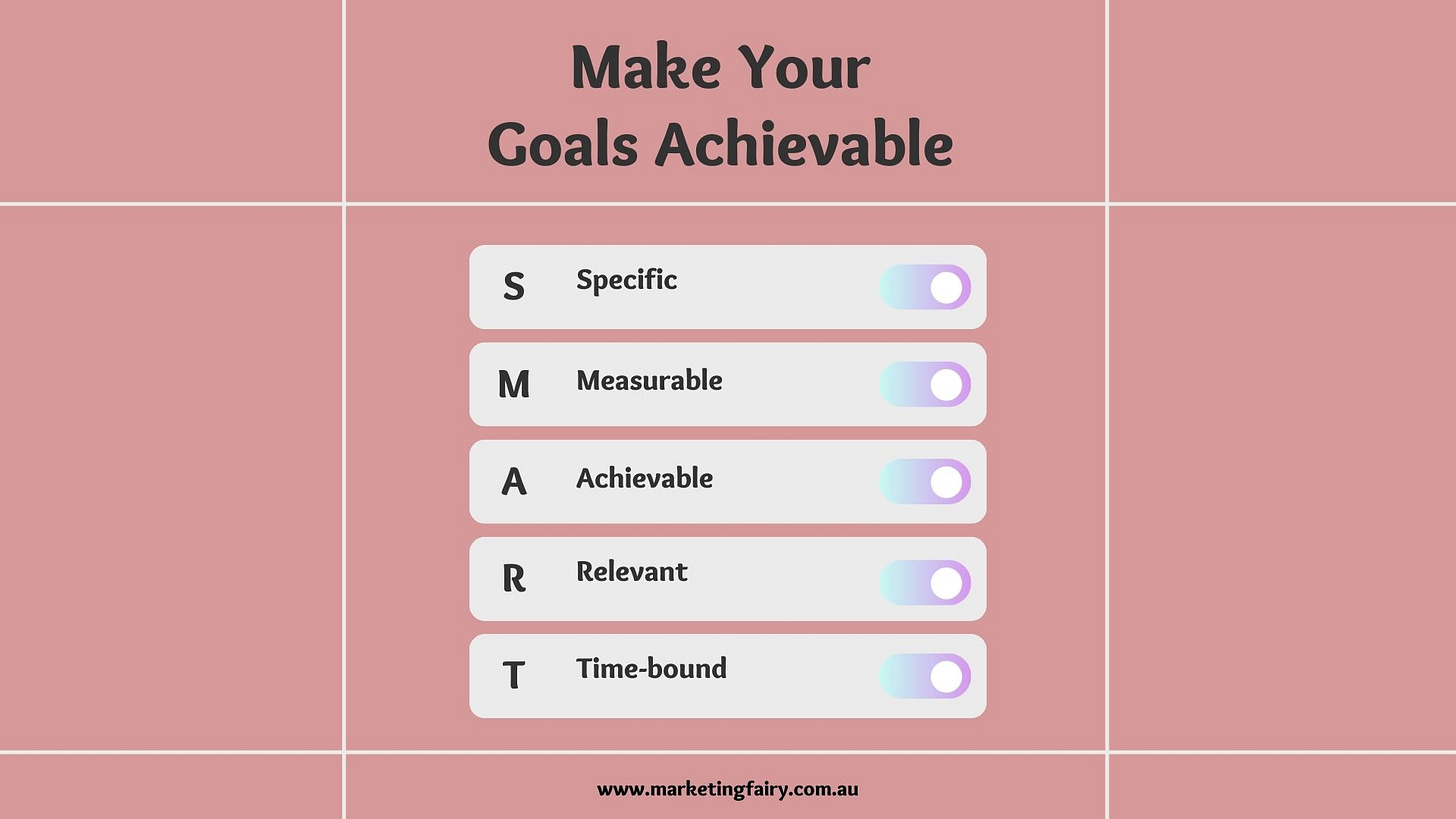Overwhelmed by Marketing? Five Straightforward Steps to Get you Unstuck
Get actionable tips from my 15+ years marketing experience and find your own marketing patway

Hi friend,
I have to admit something. Despite having 15 years of experience in marketing and PR, I'm sometimes overwhelmed with marketing. So, if you feel you don’t know where to go next, if your offer is good, and how to attract the right audience, you're not alone, my friend.
Many small business owners struggle to know where to begin with their marketing, especially when juggling multiple responsibilities.
I've been there too.
I often think about what I wish I had known back then and how much time I could have saved if I'd had some basic steps for setting up a marketing foundation.
You know, when I was trying to figure it all out while running my own business, dealing with the challenges of raising three kids, and immigrating to Australia, it felt like I was constantly putting out fires.

I felt overwhelmed and confused. I spent time on trivial matters while significant steps to enhance my marketing were overlooked.
That's why I wrote a book about it. I wanted to give you the kind of clear guidance I wish I'd had.
But I also want to give you a short version here, so you can jump-start your marketing and make changes today.
Because the process can be easy and straightforward, but at the end of the day, YOU need to do your homework. Without your involvement and understanding, it isn't easy to move the needle and see the real-life benefits from marketing.
So, let's dive in. In this issue, we'll cover:
Defining your target audience
Setting SMART goals
Creating a basic marketing plan
Branding basics for small businesses
Marketing Budget 101
1. Know Your Audience: Who Are You Talking To?
You can't sell to everyone; trying to do so will spread your efforts (and budget) too thin. Understanding your ideal customer is the most crucial step in any marketing effort.
Why? Because it allows you to:
Craft targeted messages: Speak directly to their needs and pain points.
Choose the proper channels: Reach them where they're already spending their time. Don’t waste your time on channels that do not have traction
Develop products/services that customers (not you) want: Solve their problems effectively. I can’t stress enough how important this is.
Actionable Tip: Create a simple customer profile. Not fancy 5 Ideal Customer Profiles. Just one - and answer these questions:
What are their demographics (age, location, industry, etc.)?
What are their biggest challenges and pain points related to your industry?
What are their goals and aspirations?
Where do they go for information (websites, social media, etc.)?
Bonus Tip: Some people create more than one ideal persona. Don’t stretch yourself thin - for start, create just one persona, but in different stages of their life (I borrowed this idea from Amy Porterfield).
2. Set SMART Goals: Where Do You Want To Go?
"Get more customers" is not a goal; it's a wish. To be effective, your marketing goals need to be SMART:
Specific: Clearly define your goal (e.g., "Increase website traffic").
Measurable: Quantify your goal (e.g., "Increase website traffic by 20%").
Achievable: Set realistic goals that you can reach with your resources.
Relevant: Ensure your goals align with your overall business objectives.
Time-bound: Set a deadline for achieving your goal (e.g., "Increase website traffic by 20% in 3 months").
Example:
Bad Goal: Get more leads.
SMART Goal: Increase qualified leads from organic search by 15% by the end of Q2.
Try to create yearly business goals, and then from them, your marketing goals. Then separate these goals into smaller steps, and set them up as quarterly SMART goals.
3. Create a Basic Marketing Plan: Your Roadmap to Success
A marketing plan doesn't have to be a 50-page document. For solopreneurs and small businesses, it can be a simple one-page roadmap that outlines your key marketing activities. So, you can be focused and sharp, not overwhelmed and burned out.
Key Elements:
Objectives: What do you want to achieve? (Refer back to your SMART goals)?
Strategies: How will you achieve your objectives? (e.g., content marketing, email marketing, social media marketing)
Tactics: What specific actions will you take? (e.g., write two blog posts per week, send a weekly newsletter, post daily on Instagram)
Budget: How much will you spend? (Even if it's just your time)
Timeline: When will you do it? (Create a realistic schedule)
4. Branding Basics: Stand Out from the Crowd
Branding is more than just a logo; it's your unique identity. It's what makes you recognisable and memorable to your audience.
Key Elements:
Logo: A visual symbol that represents your business.
Colour Palette: The colours you use in your marketing materials.
Typography: The fonts you use.
Brand Voice: The personality and tone of your writing and communication.
Core Values: The fundamental beliefs that guide your business and actions.
Tips for Small Businesses:
Keep it consistent: Use the same logo, colours, and fonts across all your marketing channels.
Be authentic: Let your personality shine through in your brand voice.
Focus on your unique value proposition: What differentiates you from your competitors? Keep that in mind every time you create content for your audience.
5. Marketing Budget 101: Investing in Your Growth
You don't need a huge budget to start marketing your business. But you need to be aware - if you don’t spend money, you must spend more time proportionally. When you buy ads, you buy a shortcut to more traffic to leads; When you buy someone to help you with marketing, you buy use-ready expertise - yes, you can learn these things, but how long would it take? How much effort do you need?
Key Considerations:
Time vs. Money: How much time can you invest in yourself, and how much money can you afford to spend on tools or outsourcing?
Prioritise: Focus on the most cost-effective channels for your business (e.g., content marketing, social media, email marketing). Also, build organic channels first - once that works and you have a proven record of success, you can scale with ads.
Start small and scale up: Begin with a modest budget and gradually increase it as you achieve results.
Track your spending: Monitor your expenses to see what's working and what's not.
General Budget Guidelines:
Industry guidelines often suggest allocating 5-15% of gross revenue to marketing - this IS NOT a rule of thumb anymore, but you can use it as an initial guide. Newer businesses might need to invest a higher percentage initially. The company I work for spends only 2 to 3% of its income on marketing, but being a multi-million dollar business, we spend a lot on marketing. Also, don’t stress about it at the beginning, and don’t look at it as an expense - good marketing is ALWAYS an investment.
Should you budget paid ads from the start?
I believe in paid advertising - reaching big audiences with relatively little money has never been easier. But, please, don't go into paid advertising if your content marketing is not sorted out, if your organic content isn't great, if your messaging, landing pages, sales pages, CTAs are not outstanding. Because getting traffic is not a problem, but converting is. Build your foundation, then walls and roof.
The Power of Consistent Content (and Where to Find Ideas)
You don't write to yourself, but you are constantly trying to connect to your audience. Whether through social media (Facebook, Instagram, TikTok, LinkedIn, YouTube) or email newsletters, consistent communication builds stronger connections and keeps you top-of-mind.
But let's be real: coming up with fresh content daily can feel impossible.
Luckily, a simple mindset shift can make this much easier: Document, don't create.
Instead of stressing over crafting something entirely new every day, focus on capturing what you're already doing.
Here's how this applies to your small business marketing:
Document your process: Share behind-the-scenes glimpses of how you work, the challenges you overcome, and the lessons you learn. Share some behind-the-scenes insights.
Capture customer interactions: With their permission, share success stories, answer common questions, or address pain points you've helped them solve.
Reflect on your daily activities: Turn everyday experiences—inside or outside your business—into valuable insights for your audience.
Share struggles and lessons. At the end of the day, people buy from people.
Don't forget Email Marketing
Unlike social media, where algorithms often dictate what your audience sees, email offers a more direct and intimate way to connect. This makes it the perfect platform to share the documented experiences that provide value and foster relationships.
But I know how challenging is to write newsletters regularly How you can help yourself?
Establish templates: Have an outline for your newsletter, segments you want to have every time, and a designed template where you just fill in the blanks.
Create automated sequences: Welcome, sales, upsell, and evergreen newsletters. Once you set up these sequences, you can easily write one monthly newsletter and stay in regular touch with your audience. Watch this space as I’ll break down this process in some of the following newsletters.
Create Your Own "Story Bank”: I spend 10-15 minutes each week reviewing my calendar, messages, and notes to log any relevant anecdotes or experiences. This becomes a bank of ideas I can draw from whenever I need inspiration for my newsletter.
BONUS: You can copy and use my idea bank template for free.
Sign up here to learn more about a done-for-you email automation package to help you automate your email, save 5 to 8 hours per week and nurture your leads the right way. Don’t miss it.
So, I have one question for you: What will you capture today?
What's your biggest challenge when it comes to defining your target audience for your small business? Share your thoughts in the comments below, and I'll do my best to provide personalised advice.
Want to Start Right in Less Than 7 Days?
If you just started your small business and want to start content marketing but don't know how, this e-book is your solution to avoid procrastination, confusion, and being overwhelmed.
This ebook is your battle-tested blueprint to content marketing mastery – no fancy degrees or huge budgets needed!
Start doing your marketing simply and effectively.
You don’t need to know everything about marketing. You need seven days of deep thinking and creating a basic system that will allow you to leverage your content marketing efforts and scale your business over time with the right tools and systems.
Here’s the juicy content waiting for you inside:
A day-by-day battle plan to build your content marketing strategy, ditching the confusion for immediate progress (because who has time for frustration?).
Actionable steps that help you create content consistently without burning out.
Workbook and instructions to create the content marketing system that works for you and your business - because YOU need to do the work and I’ll show you how, step by step.
+ BONUS: If you’re happy to leave me a review after you read a book and use your Workbook, you’ll get an additional 1 Hour of FREE consultation to help you ignite your marketing. Don’t miss this great opportunity to pick up my brain and get personalised advice and solve your burning marketing problem.
Cheers,
Angelina



